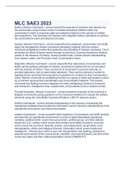MLC SAE3 2023
Define- Mission Command - correct answerThe exercise of authority and direction by
the commander using mission orders to enable disciplined initiative within the
commander's intent to empower agile and adaptive leaders in the conduct of unified
land operations. This develops the situation and integrate military operations to achieve
the commander's intent and desired end state.
Explain- Mission Command - correct answerFurther explained, commanders and staffs
apply the foundational mission command philosophy together with the mission
command warfighting function that guided by the principles of mission command. The 6
principles are Build cohesive teams through mutual trust, Exercise disciplined initiative
(action in the absence of orders), Accept prudent risks, Create shared understanding,
Use mission orders, and Provide a clear Commander's intent.
Elaborate- Mission Command - correct answerFurther elaborated, Commanders and
staffs use the guiding principles of mission command to balance the art of command
with the science of control. They use the art of command to exercise authority, to
provide leadership, and to make timely decisions. They use the science of control to
regulate forces and direct the execution of operations to conform to their commander's
intent. Mission command as warfighting function is a group of tasks and systems united
by a common purpose that commanders use to accomplish missions. The mission
command war fighting function integrates the other warfighting functions (movement
and maneuver, intelligence, fires, sustainment, and protection) into a coherent whole.
Provide Examples- Mission Command - correct answerAn example of this would be a
Brigade Commander giving guidance to the maneuver battalions to include the artillery
elements using the Joint Battle Command-Platform (JBC-P) network system.
Define-Understand - correct answerUnderstanding is the process of analyzing the
operational variables that provides the information used to develop understanding of the
operational environment and frame the problem.
explain-Understand - correct answerFurther explained, Commanders and staffs analyze
and describe an operational environment in terms of eight interrelated operational
variables: political which covers their government, political group, and their attitude
toward the U.S., military which covers their military and military functions, economy
which covers the economic diversity, activity, and employment, social which cover
demographics, ethnic and religious diversity, information which covers media and
intelligence , infrastructure which covers the transportation and building architecture,
physical environment which covers terrain, weather, and natural hazard, and time which
covers key dates and their cultural perception of time (PMESII-PT).
, Elaborate-Understand - correct answerFurther elaborated, analysis develops
understanding of the OE and frame the problem which is impeding the commander from
achieving their desired end state. Information collection such as reconnaissance,
surveillance, and intelligence preparation of the battlefield (IPB) are necessary in
improving the commander's understanding. IPB is a systematic, continuous process of
analyzing the threat and other aspects of an operational environment within a specific
geographic area. The four IPB steps are; Define the operational environment, Describe
environmental effects on operations. Evaluate the threat. Determine threat courses of
action.
Define-Visualize - correct answerMental process of developing a situational
understanding and envisioning the sequence of events in order to achieve the desired
end state. Commanders accomplish this using the mission variables associated with
METT-TC.
Explain-Visualize - correct answerFurther explained, the commander filter relevant
information categorized by the operational variables into the categories of the mission
variables used during mission analysis. They use the mission variables to refine their
understanding of the situation. The mission variables consist of mission which consist of
the task and purpose, enemy which consist of their strength, equipment, and
capabilities (IPB), terrain and weather which covers terrain features that can affect the
mission (OAKOC), troops and support available consist of the type, capabilities and
conditions of friendly troops, time available consist of the time to plan, prepare and
execute the operation, and civil considerations Civil considerations which comprises of
six characteristics which are areas, structures (SWEATMSO), capabilities
(SWEATMSO), organizations, people, and events.
Elaborate-Visualize - correct answerFurther elaborated, Once the commander has
visualized the end state of the operation, he can begin conceptualizing his operational
approach. The commander chooses the operational approach by picking the decisive
action of offense, defense, stability and defense support of civilian authorities (DSCA).
Commanders must be able to foresee future conditions that make the situation
acceptable, bring about mission success and leave the force postured for the next
operation.
Provide Example-Visualize - correct answerFor example, General Buford visualized the
end state of the battle of Gettysburg with his staff.
Define-Describe - correct answerCommander visualizes the operation and then
describes it to their staff and subordinates commander, and Soldier. Commanders
express their visualization in 4 terms that include the; Commander's intent, planning
guidance, Commander's Critical Information Requirements (CCIR), and Essential
Elements of Friendly Information (EEFI).
Explain-Describe - correct answerFurther explained, the Commander's intent is a clear
and concise expression of the purpose of the operation and the desired end state.




